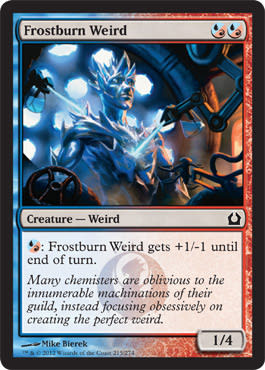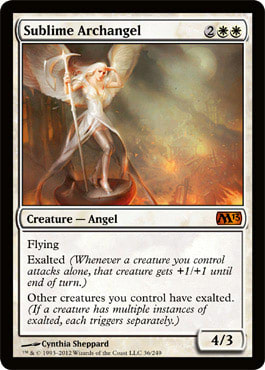Magic is a very competitive game with clearly defined winners and losers. Naturally, every competitor is constantly seeking ways to do more winning and less losing. Thus, competitive Magic becomes a constant search for advantage. This search is well illustrated by the principles of good deck design and good play.
To best understand how to build a winning deck and how best to pilot a deck to victory, it’s important to understand how your deck gains its advantage. There are many types of advantage in Magic: board advantage, card advantage, life advantage, tempo advantage, and ultimately, game advantage. You need to understand each of these and the ways to accomplish them. You also need to figure out which one your deck is trying to achieve and how it’s trying to do so.
Most Magic players know board advantage when they see it. They also usually understand the basic idea involved with achieving it:
- Your goal is to have superior permanents in play than your opponent does.
- You play high quality permanents.
- You remove your opponent’s best permanents.
- You have better/more permanents in play, board advantage achieved.
A high quality deck will typically have a specific, focused approach to achieving board advantage. The most basic approach is the standard approach for Sealed play: Have bigger, more efficient creatures.
A great example of this in Return to Ravnica Sealed is Frostburn Weird. As a 1/4 for 2, it shuts down the legion of 2/1s, 1/1s, and even 3/1s in the format that hit the board early. Thanks to its pump ability, it can even be used to trump 2/2s; plus, it will trade with almost anything else that hits the board early. Thus, it’s an example of a card that can be used to single-handedly neutralize your opponent’s first several plays–because it’s so oversized for its cost.
A more obvious example is Loxodon Smiter. In a format absolutely bursting with 3/3s, it comes out early and dominates the board. A 4/4 for 3? Talk about weight control issues, this guy is fat, without the PH.
Sure, you can’t gain advantage by attacking into a wall of 3/3s with a 4/4, but if it can hold off a bunch of 3/3s until you can make it to the late game and start playing even bigger bombs, it’s done its job. Designing a basic Standard deck can often be like assembling a deck from a completely busted Sealed pool. You choose the biggest, most efficient early-game creatures available in the format that you have the mana to cast and use them to get you to the late game, where you truly gain board advantage with powerful late-game creatures that many other decks aren’t running.
Of course, what works in Limited is rarely good enough in Constructed. Not only is your opponent not required to play with worse creatures than you, he has a lot of options for avoiding the problems presented by your creatures.
The two main approaches to board advantage in Constructed are the aggressive approach and the controlling approach. Typically, aggressive decks eschew late-game creatures in favor of playing a greater number of early-game threats and thus lessening the chance of missing early drops. In order to maintain board advantage if big blockers start hitting play, aggro decks come equipped with either pump, removal, burn, or some combination of the three.
Currently, in both Draft and Standard, we see Selesnya decks being built around aggression with pump. G/W features some of the biggest, most efficient creatures at every mana cost. If a G/W player’s opponent is able to land either a big enough or a large enough number of creatures to set up a good block, however, the G/W player can then turn the tables with a well-placed pump spell during combat. Selesnya is so ridiculous in Standard that these players use primarily sorcery-speed pump that their opponents can sort of see coming, such as Sublime Archangel, Rancor, Silverblade Paladin and Wolfir Silverheart. This ends up making their previously-only-slightly-obese attacker so big that seeing it coming is little help—you will often end up having to chump-block or die. Unlike instant-speed pump, though, the problem doesn’t evaporate at the end of the turn.
Zombie decks use cards such as Tragic Slip, Ultimate Price, Murder and Dreadbore to simply remove wannabe blockers that would otherwise force them to stop attacking. Red decks will back up their early creatures with burn. If their opponents also have small creatures, they can be removed with burn. If their opponents survive long enough to play big creatures, the burn can be used to finish off that player’s life total directly.
While these sorts of aggressive decks have been doing a good job in Standard play of gaining the advantage completely enough and long enough to win a lot of games, there are also plenty of control decks finding their own methods of gaining the advantage.
Given that control decks are built for the long game, they almost inevitably lose the advantage to aggressive decks in the early game. So, job number one for control decks isn’t finding and taking the advantage, it’s removing the opponent’s advantage and bringing the situation back to level before it’s too late. While many control decks use early blockers such as Augur of Bolas, Spirit tokens, Snapcaster Mage, and Restoration Angel, the key to eliminating the advantage of aggressive decks usually lies in good removal such as Detention Sphere, Supreme Verdict, Bonfire of the Damned, and Terminus used in a timely fashion.
While most ways of gaining advantage in Magic are seen frequently in both Limited and Constructed, some of the more exotic methods are only seen commonly in Constructed. In Limited, it’s pretty common to try to win through board advantage and card advantage gained in pretty vanilla ways such as with big creatures, mass removal, and card-draw. It’s also pretty common to make a low-curve deck with some combination of bounce, burn, and/or removal that tries to gain advantage though tempo and life advantage.
In Constructed, a player can gain advantage in some rather exotic ways, however. My favorite (not surprisingly) is through using my graveyard. Not only am I able to use my cards while they’re in my hand and while they’re in play, but in the right deck, I can use cards from my graveyard as well. Abilities that you can actively use from your graveyard such as flashback and scavenge are a clear form of card advantage, but other cards can passively help you from the graveyard, such as any creature card when you’re playing with cards like Splinterfright or Boneyard Wurm. In Constructed, it’s important to not limit yourself to traditional locations such as your hand, your board, and the top of your library when looking for an advantage.
The other fairly recent way to gain advantage that comes up mainly in Constructed is with planeswalkers. While they may vary in their power levels, they all are powerful by their very nature, which isn’t terribly surprising given what they represent from a flavor perspective.
Worst-case scenario, a planeswalker usually gives you the choice of a couple decent to quite powerful abilities that are the equivalents of sorceries and then diverts some or all of your opponent’s damage for a turn. Best-case scenario, for the cost of one sorcery you enjoy a sorcery-like ability every turn, ending up with an ability that will probably win you the game. Many are so powerful that it can make sense to play four of them in a deck even though they’re all legendary.
The thing that all of these ways of gaining advantage have in common is that their abilities to gain you advantages increase when you focus your deck around them and synergize your whole deck toward gaining that advantage. If you’re trying to gain your advantage through a swarm of cheap, aggressive creatures, your strategy is much more likely to succeed if your whole deck consists of cheap creatures and ways to support them—such as removal or pump. If you’re trying to gain an advantage with cards that can be reused from your ’yard, your deck becomes much more powerful if you have ways to efficiently fill your graveyard while productively doing something else. If you have a deck with a lot of planeswalkers, having the removal and/or blockers to protect them so you can keep using them makes them even more powerful.
So, when you’re considering how best to design and/or play a deck, be sure to consider the following:
- What is/are your primary way(s) of gaining advantage?
- What are the best ways for you to support and promote that advantage through deck focus and synergy?
- What lines of play will help you gain your advantage fastest and most completely?
Asking yourself these questions and understanding the answers can help lead you to a better deck design and better lines of play. If you don’t like the answers you’re coming up with, it might be time to consider going back to the drawing board.


























